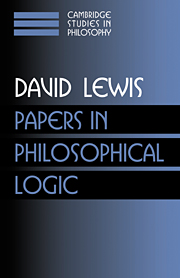Book contents
- Frontmatter
- Contents
- Dedication
- Introduction
- 1 Adverbs of quantification
- 2 Index, context, and content
- 3 ‘Whether’ report
- 4 Probabilities of conditionals and conditional probabilities II
- 5 Intensional logics without iterative axioms
- 6 Ordering semantics and premise semantics for counterfactuals
- 7 Logic for equivocators
- 8 Relevant implication
- 9 Statements partly about observation
- 10 Ayer's first empiricist criterion of meaning: why does it fail?
- 11 Analog and digital
- 12 Lucas against mechanism
- 13 Lucas against mechanism II
- 14 Policing the Aufbau
- 15 Finitude and infinitude in the atomic calculus of individuals (with Wilfrid Hodges)
- 16 Nominalistic set theory
- 17 Mathematics is megethology
- Index
6 - Ordering semantics and premise semantics for counterfactuals
Published online by Cambridge University Press: 05 June 2012
- Frontmatter
- Contents
- Dedication
- Introduction
- 1 Adverbs of quantification
- 2 Index, context, and content
- 3 ‘Whether’ report
- 4 Probabilities of conditionals and conditional probabilities II
- 5 Intensional logics without iterative axioms
- 6 Ordering semantics and premise semantics for counterfactuals
- 7 Logic for equivocators
- 8 Relevant implication
- 9 Statements partly about observation
- 10 Ayer's first empiricist criterion of meaning: why does it fail?
- 11 Analog and digital
- 12 Lucas against mechanism
- 13 Lucas against mechanism II
- 14 Policing the Aufbau
- 15 Finitude and infinitude in the atomic calculus of individuals (with Wilfrid Hodges)
- 16 Nominalistic set theory
- 17 Mathematics is megethology
- Index
Summary
COUNTERFACTUALS AND FACTUAL BACKGROUND
Consider the counterfactual conditional ‘If I were to look in my pocket for a penny, I would find one’. Is it true? That depends on the factual background against which it is evaluated. Perhaps I have a penny in my pocket. Its presence is then part of the factual background. So among the possible worlds where I look for a penny, those where there is no penny may be ignored as gratuitously unlike the actual world. (So may those where there is only a hidden penny; in fact my pocket is uncluttered and affords no hiding place. So may those where I'm unable to find a penny that's there and unhidden.) Factual background carries over into the hypothetical situation, so long as there is nothing to keep it out. So in this case the counterfactual is true. But perhaps I have no penny. In that case, the absence of a penny is part of the factual background that carries over into the hypothetical situation, so the counterfactual is false.
Any formal analysis giving truth conditions for counterfactuals must somehow take account of the impact of factual background. Two very natural devices to serve that purpose are orderings of worlds and sets of premises. Ordering semantics for counterfactuals is presented, in various versions, in Stalnaker [8], Lewis [5], and Pollock [7]. (In this paper, I shall not discuss Pollock's other writings on counterfactuals.) Premise semantics is presented in Kratzer [3] and [4].
- Type
- Chapter
- Information
- Papers in Philosophical Logic , pp. 77 - 96Publisher: Cambridge University PressPrint publication year: 1997



